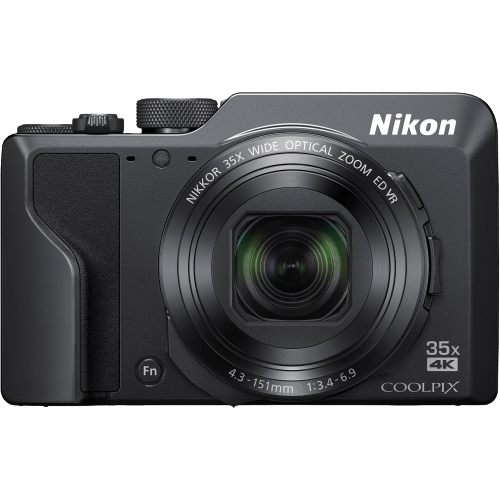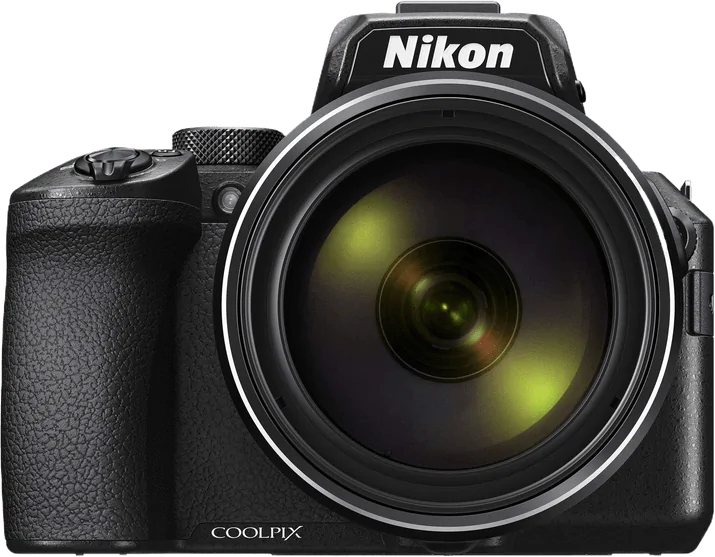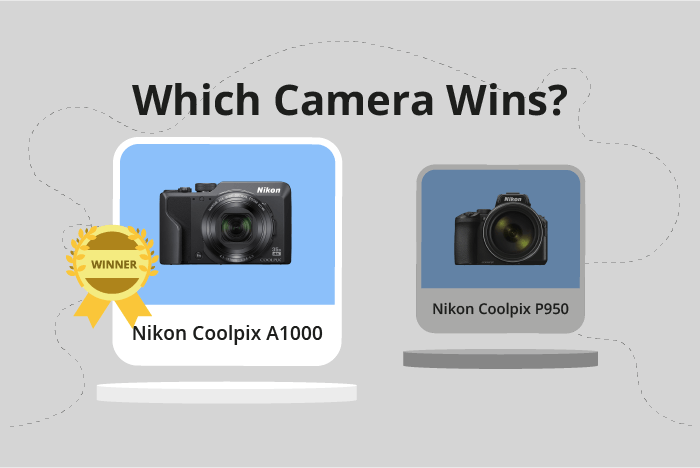Nikon Coolpix A1000 vs Coolpix P950 Comparison
Nikon Coolpix A1000

Nikon Coolpix P950

The Nikon Coolpix A1000 takes the lead with a score of 53/100, just one point ahead of the Nikon Coolpix P950 at 52/100. Both cameras share common specifications, such as being released in 2019 and 2020, respectively. The A1000, a compact camera, has its advantages with a lower launch price of $479 and a lighter weight of 330g.
On the other hand, the P950, a bridge camera, has its merits despite its higher launch price of $799 and heavier weight of 1005g. It offers a larger camera size, measuring 140 x 110 x 150mm, which may appeal to some users.
Comparing the two cameras, the A1000 holds a slight edge due to its lower price and lighter weight, making it a more affordable and portable option. However, the P950’s larger size may be preferable for those seeking a more substantial camera.
Nikon Coolpix A1000 vs Coolpix P950 Video Performance
The Nikon Coolpix P950 outperforms the Nikon Coolpix A1000 in video capabilities, with a video score of 83/100 compared to the A1000’s score of 70/100. This 13-point difference highlights the superior video features of the P950.
Both cameras share some common video specifications, such as the maximum video resolution of 4K and maximum video dimensions of 3840 x 2160. Additionally, both cameras have built-in time-lapse functionality, making them suitable for capturing creative time-lapse videos.
The P950 surpasses the A1000 in video performance due to its higher maximum video frame rate. The P950 can record at 60fps, allowing for smoother and more detailed video capture compared to the A1000’s maximum frame rate of 30fps. This higher frame rate is particularly beneficial for capturing fast-moving subjects or creating slow-motion footage.
The A1000, however, does not offer any significant advantages over the P950 in terms of video capabilities. The lower video score reflects its limitations compared to the P950, particularly in the frame rate department.
Taking these factors into account, the Nikon Coolpix P950 emerges as the clear winner in terms of video performance. The higher video score, coupled with the superior maximum video frame rate, makes the P950 a better option for those prioritizing video quality and versatility in their camera choice. While the A1000 also offers 4K video resolution and built-in time-lapse functionality, its lower frame rate and overall video score indicate that it is not as strong a contender as the P950 in the realm of video capture.
Nikon Coolpix A1000 vs Coolpix P950 Features and Benefits
The Nikon Coolpix P950 outperforms the Nikon Coolpix A1000 in terms of features, scoring 57/100 as opposed to the A1000’s 54/100. Both cameras share several common specifications, including a flip screen, GPS absence, and WIFI connectivity. However, there are differences that make one camera stand out over the other.
The P950 excels with its larger 3.2-inch screen, offering a slightly higher resolution of 921,600 dots compared to the A1000’s 3-inch screen with 921,000 dots. Additionally, the P950 benefits from Bluetooth connectivity, allowing for seamless transfer of images and remote control of the camera. These advantages make the P950 a more feature-rich choice for photographers seeking convenience and ease of use.
On the other hand, the A1000 offers a touchscreen interface, providing users with a more intuitive way of navigating through the camera’s settings and options. This feature can be particularly useful for photographers who prefer a more hands-on approach when adjusting settings or selecting focus points. Although the A1000 loses in terms of overall features, the touchscreen capability is a noteworthy advantage.
Considering these points, the Nikon Coolpix P950 emerges as the superior camera in terms of features due to its larger screen, higher resolution, and Bluetooth connectivity. The A1000, though scoring lower, has the advantage of a touchscreen interface. Ultimately, the choice between these two cameras will depend on the individual preferences of the photographer and their specific needs.
Nikon Coolpix A1000 vs Coolpix P950 Storage and Battery
The Nikon Coolpix A1000 and the Nikon Coolpix P950 have an equal storage and battery score of 29/100. Both cameras have one memory card slot and accept SD, SDHC, and SDXC memory cards. They also both feature USB charging capabilities.
The Nikon Coolpix P950 outperforms the A1000 in battery life, offering 290 shots compared to the A1000’s 250 shots. This is due to the P950 using the EN-EL20a battery type. The longer battery life makes the P950 more suitable for extended shooting sessions.
On the other hand, the Nikon Coolpix A1000 uses the EN-EL12 battery type. However, this does not provide any advantage over the P950 in terms of storage and battery performance.
Since both cameras share the same storage and battery score and have similar specifications, neither camera has a significant advantage over the other in this category. The P950’s longer battery life is the only notable difference, making it slightly more suitable for prolonged use.
Nikon Coolpix A1000 vs Coolpix P950 – Our Verdict
Are you still undecided about which camera is right for you? Have a look at these popular comparisons that feature the Nikon Coolpix A1000 or the Nikon Coolpix P950:

